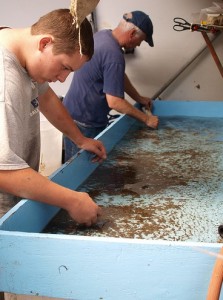 To change people’s values, so the shrinks say, you change their behavior. You don’t barrage them with ideas and cause information overload. You don’t tell them their existing values are wrong and get their backs up.
To change people’s values, so the shrinks say, you change their behavior. You don’t barrage them with ideas and cause information overload. You don’t tell them their existing values are wrong and get their backs up.
What you do is you get them to change their behavior and, once you’ve done that, you let their ideas and values change all by themselves. “What a great idea we’ve come up with,” they’ll say.
So don’t convince people to save the world. Just get them started saving it. Once they realize what their doing, they’ll already be convinced.
But how do you get them started?
**********
This week I visited the Cornell Extension Program’s Southold Project in Aquaculture Training (SPAT, which by the way, also happens to be the name of shellfish larvae when they first settle down and start growing their shells). The SPAT program concentrates on shellfish restoration.
Shellfish restoration matters, for example, because, one hundred years ago, every drop of water in the Chesapeake Bay would pass through the gut of an oyster every seven days. Today, there are so few oysters in the Bay that it takes 380 days.
That’s a problem for two reasons. One is that oysters remove heavy metals and PCBs from the water. They literally soak up the pollution. The other is that oysters sequester carbon dioxide in their shells (they eat algae which absorbs CO2 during photosynthesis) and help mitigate climate change.
But the relatively small amount of oyster restoration at SPAT, in many ways, is not the most important part of the program. According to the SPAT web page, the program “was created to encourage community members to become stewards of their environment and to restore shellfish to the bays”
In other words, as it was explained to me by the head of the SPAT program, Kim Tetrault (pictured above), the volunteers are not there to restore the shellfish so much as the the shellfish restoration program is there to convince volunteers to become stewards of the environment.
Kim Tetrault is particularly talented at attracting and inspiring volunteers. He holds classes for them. Throws them dinners and parties. Encourages them to write and sell fundraising cookbooks. Teaches them to build boats. Lets them take long coffee breaks to socialize. Takes them snorkeling and canoeing around the saltwater creeks where the shellfish are seeded. Lets them tend to their own oyster nets and gardens.
He uses, in other words, the Tom Sawyer approach.
You know the story, right? Tom Sawyer had to paint a fence. So he sat on the ground and concentrated with all his might and made painting look like the most interesting thing he’d ever done. Soon enough, Huck Finn came along, saw how interested Tom Sawyer looked, and asked if he could paint, too. That’s the Tom Sawyer approach to getting help painting a fence.
Kim’s like Tom Sawyer except that he applies the tactic to saving the world.
 Retired people volunteer to fill empty time with meaningful hours. High school students volunteer for credits. Lonely people join for company. Ocean lovers join to be near the sea. Volunteers donated over 13,000 hours at SPAT last year.
Retired people volunteer to fill empty time with meaningful hours. High school students volunteer for credits. Lonely people join for company. Ocean lovers join to be near the sea. Volunteers donated over 13,000 hours at SPAT last year.
The point here is that people become involved for any number of diverse motivations. But whatever their reasons for volunteering, once Kim gets them restoring the shellfish, their values start to change. He doesn’t ask them if they want to save the world. He just gets them to save the world.
And before you know it, that’s what they want.
**********
Is this not a way forward to change minds about climate change? Might engaging citizens–actually getting them involved in volunteerism for any one of their diverse motivations–be a way to change people’s minds and values?
Photos courtesy of Cathrine Kramer. To see more of her excellent pics of SPAT, visit Cat’s Flickr page.